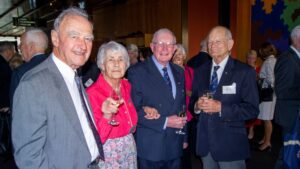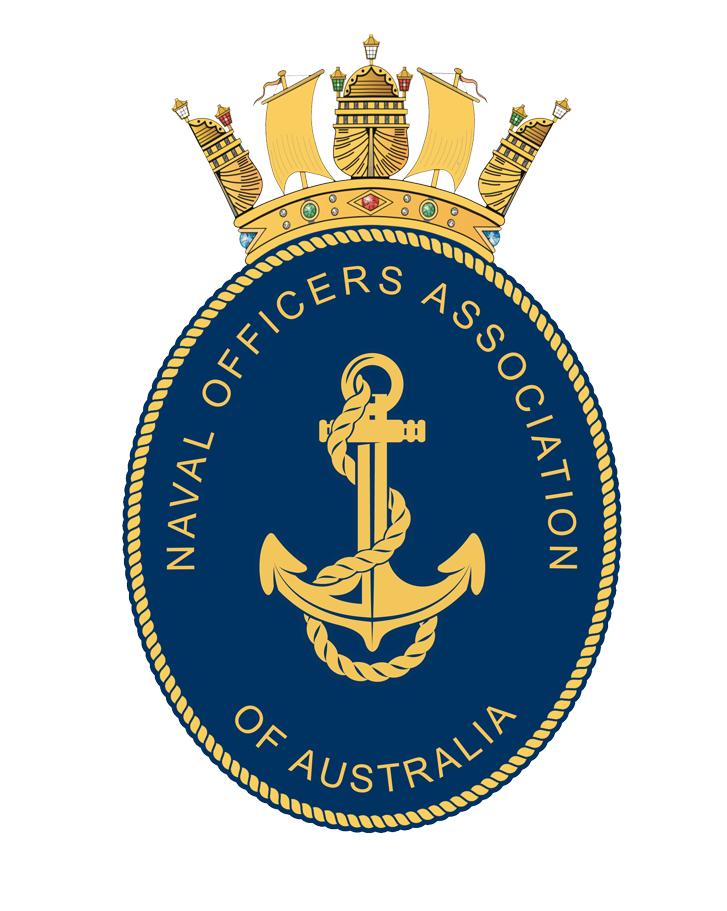
Naval Officers Club member Rear Admiral Andrew John Robertson AO DSC RAN – Navy’s most accomplished Gunnery Officer – has died at age 95 in North West New South Wales. Andrew has been an ardent supporter of the Club and he will be sorely missed at future Club functions, at which he and Pat were regular attendees. He had an incredible ability to remember people’s names and to make people feel at ease.
During more than 40 years of service to Navy, Rear Admiral Robertson’s career was full of extraordinary achievements, the highlight of which was receiving the Distinguished Service Cross for his frequent displays of gunnery skill during active service in the Korean War.
Long before this conflict, just before the outbreak of World War II in 1939, Andrew joined the Australian Navy as a 13 year old Cadet Midshipman and despite his young age, excelled in every aspect of training.
He received numerous awards for academic achievement, seamanship and sport, culminating with the prestigious King’s Medal as the Cadet Midshipmen who displayed the most exemplary conduct, performance of duty and leadership among peers.
After graduating in 1942, at the age of 17, Andrew served in HMAS Australia and HMAS Warramunga, conducting patrols and convoy escort duties in the Coral Sea, around New Guinea and off the east coast of Australia.
In 1944, then Midshipman Robertson went to England for his Sub Lieutenant’s course where true to form, he received seven first class certificates in seamanship, navigation, gunnery, torpedoes, signals, air operations and anti-submarine warfare.
The Royal Navy – wanting to use Andrew’s natural maritime skills – posted him to HMS Kimberley in the Aegean Sea, where the destroyer played a leading role in enforcing the surrender of German forces in the Dodecanese Islands in May 1945.
Returning to Australia later that year, Lieutenant Robertson joined the destroyer HMAS Bataan which was later deployed to Japan as part of the British Commonwealth Occupation Force. During this time he walked over the nuclear bomb site at Hiroshima, shortly after the bomb was dropped.
In August 1947, Andrew joined HMAS Swan which was leading the 20th Minesweeping Flotilla and conducting mine clearance operations in Australia and New Guinea. Minesweeping was long, arduous and dangerous work as demonstrated by the loss of HMAS Warrnambool with four men killed in September 1947.
The following year, Lieutenant Robertson undertook the long gunnery course at HMS Excellent Whale Island in England and once again, graduated top of his class.
Not surprisingly, on return to Australia, Andrew was posted to HMAS Cerberus in Victoria as an instructor at the Gunnery School. However, he was not to remain there for long as his unique skills were needed on the newly commissioned destroyer HMAS Anzac, which only three months later, would form part of the United Nations response to the invasion of South Korea.
Immediately on arrival in the waters off South Korea in August 1951, Anzac was put to work and saw active service while conducting aircraft carrier escort duties and fired 1000 rounds of 4.5-inch ammunition at North Korean targets ashore. Anzac returned to Australia for a refit in October that year, but was back in action in Korea the following year, where the ship again saw active service in providing naval gunfire support.
Among numerous engagements with enemy forces, the most legendary fight occurred on 16 November 1952. Anzac was at anchor protecting the garrison on Cho Do when fired on by four 76mm guns hidden in caves over 10 kilometres away. According to naval historian Vice Admiral Peter Jones, soon rounds from the mountain guns were falling around Anzac. “In this perilous situation Anzac quickly slipped her cable leaving a buoy marking the anchor. Due to the nearby shoals Anzac was prevented from making a quick seaward escape,” Vice Admiral Jones said.
“Fortunately, in a spirited fight Anzac’s guns found the caves’ entrances and the smoke and dust partly obscured the destroyer from the artillery. A running duel ensued for 23 minutes with Anzac firing 174 rounds with 50 from the enemy falling near the ship.” As Anzac’s Gunnery Officer, Lieutenant Robertson was an indispensable part of the ships many engagements with enemy forces, and for his service, was awarded the Distinguished Service Cross. According to the citation for his DSC, written in a typically understated style; ‘His calmness and disregard of personal danger when most effectively controlling the armament in a relatively prolonged action against an enemy coastal battery of four guns which hotly and accurately engaged HMAS Anzac on 16 November 1952 was most notable’.
Following the Korean War, Andrew was appointed the Australian Naval Liaison Officer in London, while simultaneously completing the Royal Navy Staff Course, and subsequently promoted to Commander in 1957.
After returning home, Commander Robertson undertook a wide range of senior appointments including Commanding Officer of HMA Ships Quickmatch and Yarra, Fleet Operations Officer, and Commander of First Frigate Squadron consisting of four River class vessels.
Rapid promotions followed, as did his level of responsibility for the quickly expanding Australian Navy including command of the fast troop transport HMAS Sydney, Commander First Australian Transport Squadron, and Commanding Officer HMAS Albatross, the Naval Air Station at Nowra New South Wales.
It was during this time that Commodore Robertson helped facilitate from Albatross the evacuation of more than 350 local residents who had been trapped in their homes after floods inundated the Nowra area. The lessons learnt from providing this disaster relief were called on four months later, when Albatross aircraft were used in the mass transit of supplies into, and people out, of Darwin following the devastation of cyclone Tracy in December 1974.
While commanding Albatross, Andrew initiated the establishment of the Australian Naval Aviation Museum, now the Fleet Air Arm Museum, which continued to benefit from his generosity and enthusiasm after his retirement. Not only did Andrew, in retirement, take an active role in procuring many of its unique exhibits, but he was also Chairman of the Committee to raise funds for and rebuild the Museum, raising with others many millions of dollars in cash and in-kind donations without which it would not have become Australia’s leading aviation museum.

L-R CAPT John Da Costa, VADM Sir James Willis, CMDR Peter Wright, RADM Andrew Robertson in a familiar mess dinner pose.
Andrew’s final promotion, to Rear Admiral, occurred in 1980 when he became Head Australian Defence Staff in the Australian High Commission in London, followed by Flag Officer Naval Support Command in Sydney. Naval Support Command was an extensive responsibility that oversaw the command and management of the majority of the RAN’s training and support bases, the Navy Supply Centre at Zetland, Sydney and the maintenance and upgrade program of all ships, submarines, aircraft and armaments. It was during this time that he was made a Freeman of the City of Sydney for enhancing the bond between Navy and the City.
Rear Admiral Robertson was made an Officer in the Order of Australia in the Queen’s Birthday Honours List 1980 for service to the Royal Australian Navy and the Defence Force, particularly as Head Australian Defence Staff London.
Andrew retired from the RAN in early 1982 after 43 years of service. Maintaining a devotion to public service, he became Vice President of the Navy League of Australia, Councillor Order of Australia Association and Chairman of Old Sydney Town Pty Ltd amongst other activities.
Rear Admiral Robertson was also the driving force behind the conception and creation of the Australian National Maritime Museum and was named the Inaugural Honorary Fellow in 2016. Andrew was also awarded the Centenary Medal in 2001 for distinguished service to business and commerce.
At age 91, Andrew was the key instigator behind the Windjammer Sailors statue in Darling Harbour and at the time of his death, was a member of 18 organisations or associations, including as Patron of the HMAS Sydney Association and Training Ship Sydney for naval cadets.
Chief of Navy Australia Vice Admiral Michael Noonan AO RAN, described Rear Admiral Robertson as a role model for what Navy officers can achieve in the most demanding of circumstances. “Rear Admiral Robertson always sought to fight through obstacles, and rose to all challenges both in war and peace,” Vice Admiral Noonan said. “One of our most admired leaders, his courage under pressure and calm demeanour in the face of adversity has set the benchmark for our Navy leaders now, and for generations to come.”
Rear Admiral Andrew Robertson is survived by his wife Patricia (Pat) and children Angus, Jane, Julia and Bruce.

At NSW Parliament House Lunch in December 2019. L-R Staff Lowe, Pat Robertson, Ralph Derbidge, Andrew Robertson
